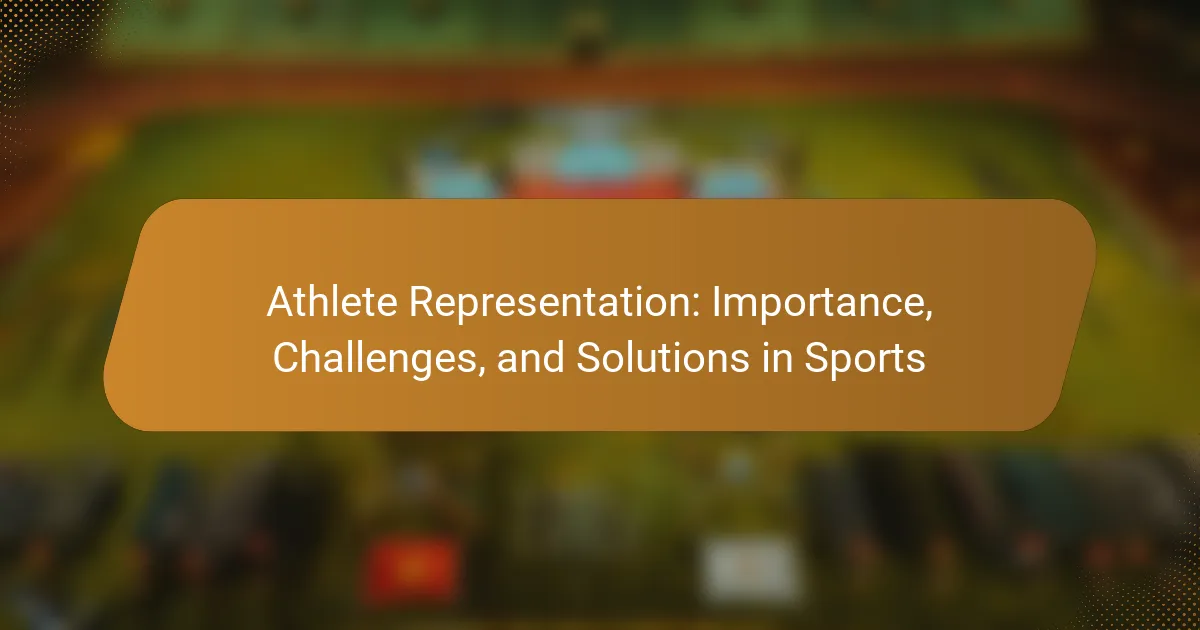Athlete representation is vital for empowering athletes and ensuring their voices are heard in sports. This article explores the importance of representation, the challenges athletes face, and potential solutions to create more equitable environments. It highlights the need for effective communication, tailored support, and strategic advocacy while addressing future trends in athlete empowerment and diversity.
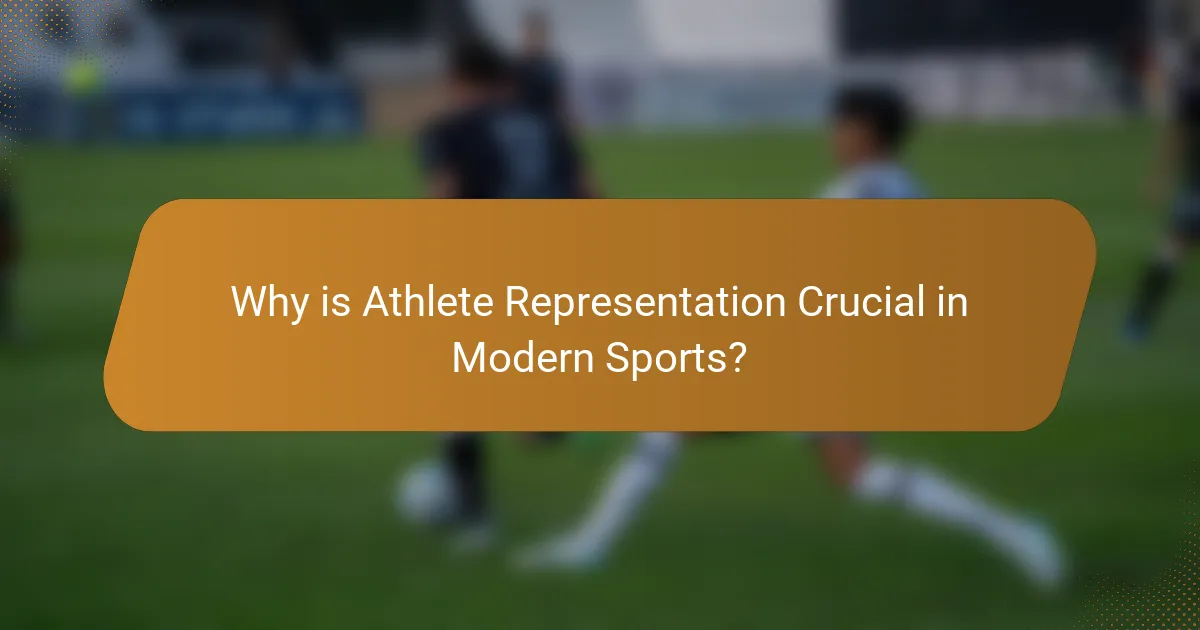
Why is Athlete Representation Crucial in Modern Sports?
Athlete representation is crucial in modern sports because it empowers athletes, ensures their voices are heard, and promotes equity. Effective representation addresses challenges like contract negotiations and health concerns. It fosters a collaborative environment that enhances athletic performance and well-being. Representation also drives social change, advocating for issues like diversity and inclusion within sports organizations.
How does Athlete Representation Impact Performance and Well-being?
Athlete representation significantly enhances performance and well-being by providing support, advocacy, and resources. Effective representation fosters a sense of belonging and security, allowing athletes to focus on their training and competition. Research indicates that athletes with strong representation report higher satisfaction and lower stress levels, ultimately translating to improved performance outcomes. Furthermore, representation helps address challenges such as mental health, contractual negotiations, and career transitions, ensuring athletes have the necessary guidance and support throughout their careers.
What Role Does Representation Play in Athlete Advocacy?
Representation plays a crucial role in athlete advocacy by amplifying athletes’ voices and addressing their concerns. With effective representation, athletes can influence policies, promote fairness, and ensure their rights are protected. Challenges include navigating power dynamics and ensuring diverse perspectives are included. Solutions involve fostering inclusive representation models and empowering athlete-led organizations.
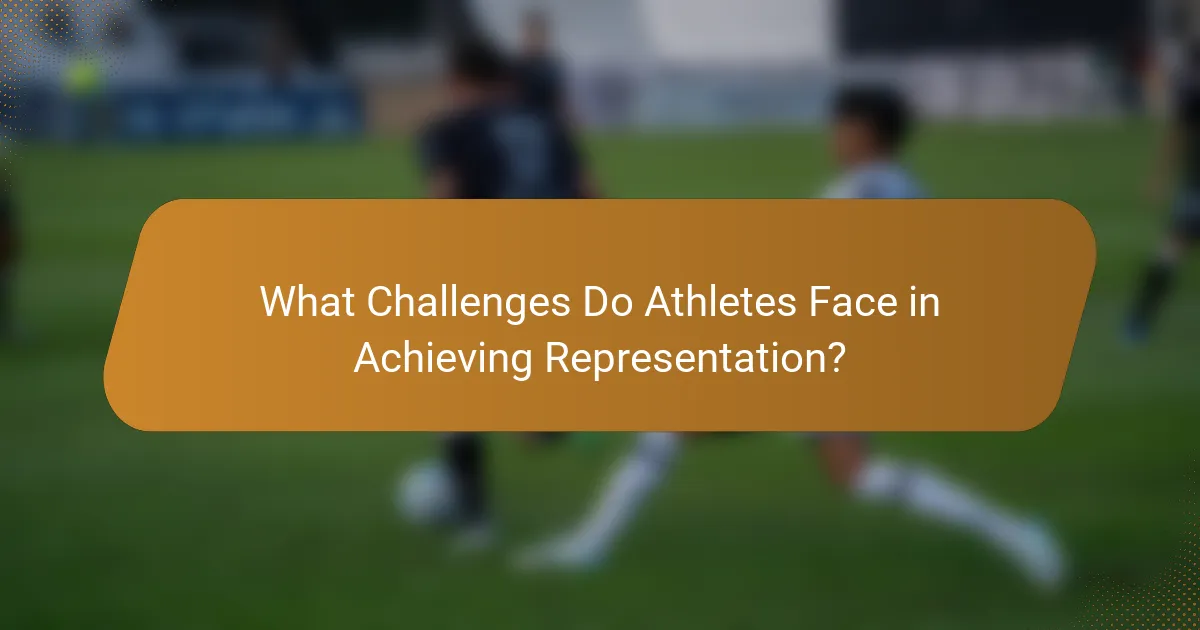
What Challenges Do Athletes Face in Achieving Representation?
Athletes face significant challenges in achieving representation, including systemic barriers, financial constraints, and lack of visibility. These issues hinder equal opportunities and often marginalize underrepresented groups. Systemic barriers include limited access to resources and support networks, which can prevent athletes from reaching their full potential. Financial constraints often limit participation, especially for those from lower socioeconomic backgrounds. Additionally, media representation is frequently skewed, favoring mainstream athletes and overlooking diverse talents. Addressing these challenges requires collaborative efforts from sports organizations, sponsors, and communities to create inclusive environments.
Which Systemic Barriers Hinder Athlete Representation?
Systemic barriers that hinder athlete representation include lack of access to resources, insufficient support systems, and cultural biases. These obstacles limit opportunities for diverse athletes to engage in sports governance and decision-making. For example, financial constraints can prevent athletes from participating in essential training or representation initiatives. Additionally, inadequate mentorship and networking opportunities often result in a lack of visibility for underrepresented groups. As a result, these systemic challenges perpetuate a cycle of exclusion in sports.
How Do Cultural Differences Affect Athlete Representation?
Cultural differences significantly impact athlete representation by shaping perceptions, opportunities, and support systems. These variations influence how athletes are perceived by fans, sponsors, and sports organizations. For example, cultural values can dictate the level of encouragement for athletes, affecting their visibility and success.
In some cultures, individual achievements are celebrated, leading to greater media attention and sponsorship opportunities. In contrast, collectivist cultures may prioritize team success, which can obscure individual athletes’ recognition. This can create challenges in marketing and representation, as brands often seek recognizable figures to endorse products.
Moreover, cultural norms around gender, race, and nationality can affect athlete representation. Female athletes may face more barriers in certain cultures, limiting their visibility and opportunities compared to their male counterparts. As a result, addressing these disparities is crucial for equitable representation in sports.
Solutions include promoting diversity in sports organizations and creating inclusive policies. This can enhance athlete representation and ensure that diverse backgrounds are acknowledged and celebrated. By fostering a more inclusive environment, sports can better reflect the diversity of their participants and audiences.
What Are the Consequences of Poor Representation for Athletes?
Poor representation for athletes can lead to significant negative consequences, including reduced visibility and support. This lack of representation can hinder athletes’ career opportunities and limit their access to resources. Furthermore, it can perpetuate stereotypes and diminish the overall integrity of the sport. As a result, athletes may struggle to advocate for their rights and needs, ultimately impacting their performance and well-being.

How Can Sports Organizations Improve Athlete Representation?
Sports organizations can improve athlete representation by actively involving athletes in decision-making processes. Engaging athletes in leadership roles fosters inclusivity and ensures diverse perspectives are considered. Additionally, implementing mentorship programs can empower underrepresented athletes, enhancing their visibility and opportunities. Research shows that organizations with diverse representation often achieve better performance outcomes. As a result, prioritizing athlete representation can lead to a more equitable and successful sports environment.
What Best Practices Should Organizations Adopt for Inclusion?
Organizations should adopt inclusive practices to enhance athlete representation. Prioritize diverse recruitment in leadership roles, ensuring decision-makers reflect the athlete population. Implement training programs focused on cultural competency to foster understanding and respect. Establish mentorship initiatives pairing experienced athletes with underrepresented groups, promoting engagement and support. Regularly assess policies for equity, making adjustments based on feedback from all stakeholders.
How Can Technology Enhance Athlete Representation?
Technology can significantly enhance athlete representation by providing platforms for direct communication and engagement. Digital tools enable athletes to share their stories, advocate for issues, and connect with fans. Social media channels amplify their voices, allowing for greater visibility and support for causes they care about. Data analytics can also inform athlete management decisions, ensuring fair representation in contracts and endorsements. Furthermore, virtual reality and augmented reality can create immersive experiences that showcase athletes’ journeys and challenges, fostering empathy and understanding among fans and stakeholders.
Which Successful Models of Athlete Representation Exist Today?
Successful models of athlete representation today include agencies, unions, and individual advocates. These models address various challenges such as contract negotiations, brand management, and athlete welfare.
Agencies like Creative Artists Agency (CAA) and Wasserman provide comprehensive services including marketing and legal support. Player unions, such as the National Football League Players Association (NFLPA), advocate for rights and benefits, ensuring athletes have a collective voice. Individual advocates, often former athletes, offer personalized guidance and mentorship, focusing on career transitions and personal branding.
Each model has unique attributes that enhance athlete representation. Agencies leverage industry connections and negotiation expertise, while unions provide collective bargaining power. Individual advocates bring personal experience and tailored support, addressing the diverse needs of athletes in a dynamic sports landscape.
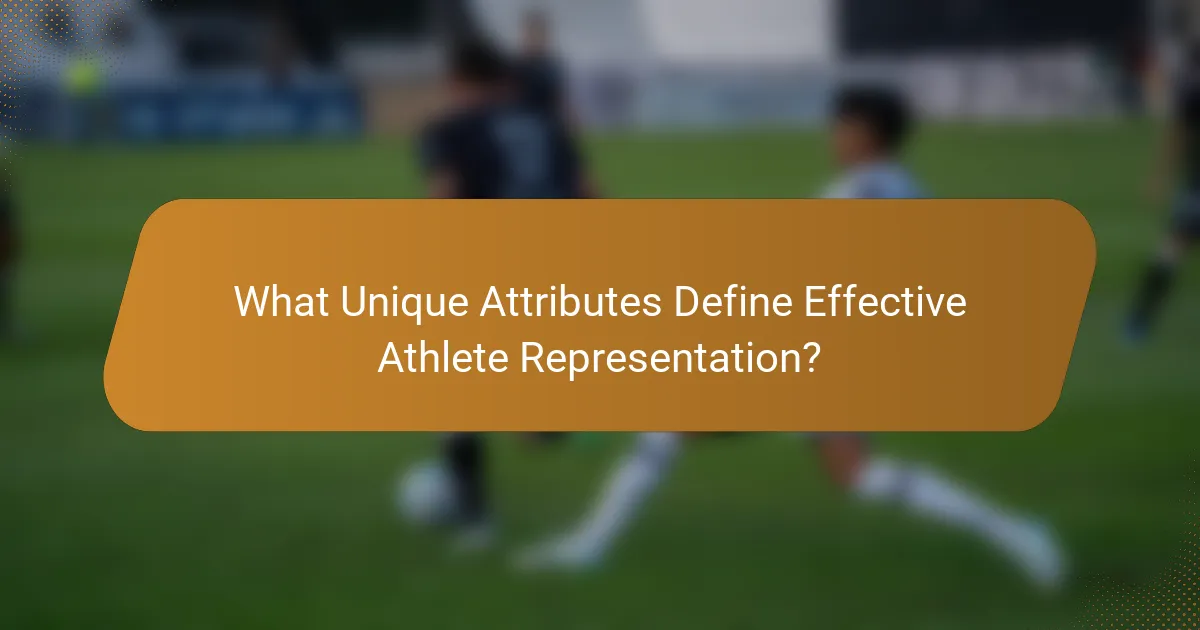
What Unique Attributes Define Effective Athlete Representation?
Effective athlete representation is defined by strong communication, tailored support, and strategic advocacy. These unique attributes ensure athletes’ needs are prioritized and their voices are amplified.
Strong communication involves transparent dialogue between athletes and their representatives. This builds trust and fosters a collaborative environment. Tailored support addresses individual athlete needs, providing personalized services such as career management and mental health resources.
Strategic advocacy is crucial for navigating complex systems in sports. Representatives must effectively negotiate contracts and promote athletes’ interests within organizations. This unique combination of attributes enhances athletes’ professional journeys and overall well-being.
How Do Personal Stories Influence Representation Efforts?
Personal stories significantly enhance athlete representation efforts by fostering empathy and connection. They humanize athletes, making their experiences relatable and impactful. Personal narratives can challenge stereotypes and promote diversity within sports. By sharing their journeys, athletes can inspire others and advocate for systemic changes in representation. This storytelling approach not only highlights unique challenges faced by underrepresented groups but also encourages broader participation and support in sports.
What Innovative Approaches Are Emerging in Athlete Representation?
Innovative approaches in athlete representation focus on empowering athletes through technology and personalized services. Digital platforms enable direct communication between athletes and their representatives, enhancing transparency. Athlete-led agencies are emerging, prioritizing athletes’ interests over traditional models. Moreover, social media allows athletes to build personal brands, increasing their marketability. These strategies address challenges like contract negotiation and public relations, promoting athlete autonomy and engagement.
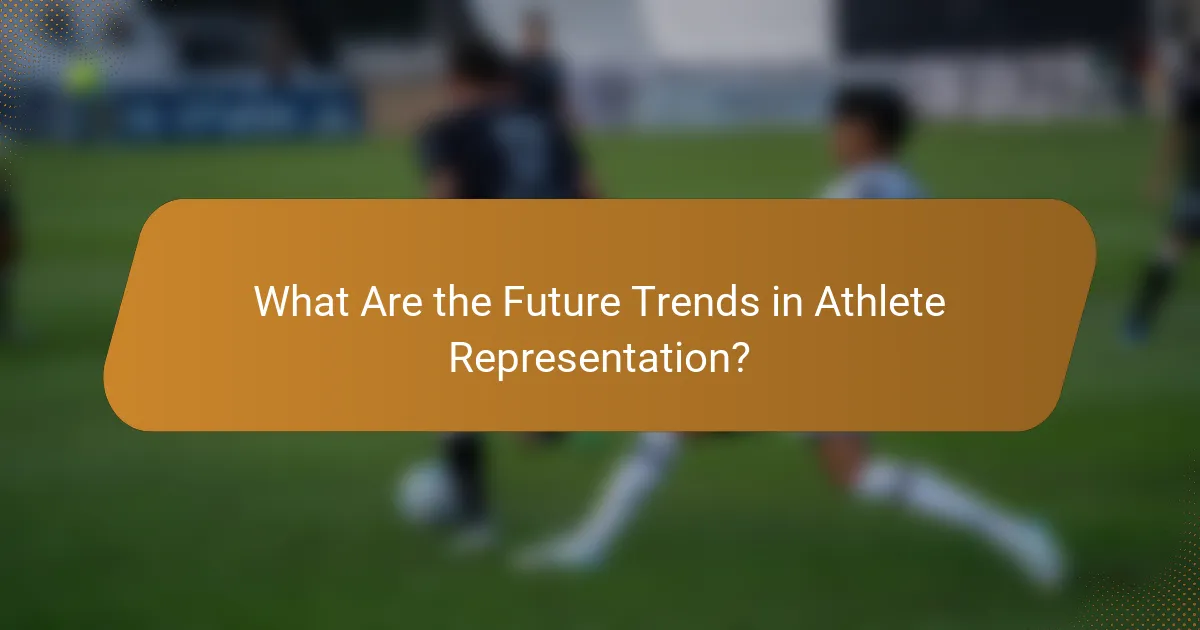
What Are the Future Trends in Athlete Representation?
Future trends in athlete representation emphasize increased athlete empowerment, digital engagement, and diversity. Athletes are gaining more control over their careers and brand identities, driven by social media and direct fan interactions. Furthermore, representation is becoming more inclusive, reflecting a wider array of backgrounds and experiences. This evolution addresses challenges like mental health awareness and equitable compensation, paving the way for innovative solutions in the sports industry.
How Will Changing Demographics Influence Athlete Representation?
Changing demographics will significantly influence athlete representation by increasing diversity and inclusivity in sports. As populations evolve, the demand for representation of various backgrounds and cultures grows. This shift can enhance team dynamics and broaden audience engagement. For instance, research shows that diverse teams often outperform homogenous ones, leading to better decision-making and creativity. Moreover, organizations that prioritize inclusive representation can attract a wider fan base, ultimately driving higher revenues. Addressing these demographic changes is crucial for the future of sports, ensuring that all athletes feel valued and represented.
What Role Will Social Media Play in Shaping Athlete Representation?
Social media will significantly influence athlete representation by providing platforms for direct communication and personal branding. Athletes can share their stories, connect with fans, and advocate for social causes. This democratization of voice allows athletes to shape their narratives and challenge traditional media portrayals. As a result, social media can enhance visibility and create opportunities for diverse representation in sports.
What Strategies Can Athletes Use to Advocate for Their Representation?
Athletes can advocate for their representation through strategic collaboration, public speaking, and leveraging social media. Collaborating with organizations amplifies their voices and creates a united front. Public speaking at events raises awareness about representation issues. Social media platforms allow athletes to connect directly with fans and stakeholders, sharing their experiences and advocating for change. Engaging in community outreach fosters grassroots support and builds a loyal following. These strategies enhance visibility and drive conversations around athlete representation in sports.
What Common Mistakes Should Athletes Avoid in Representation Efforts?
Athletes should avoid common mistakes in representation efforts to ensure effective advocacy and support. Key mistakes include neglecting to research representation options, failing to communicate openly with agents, overlooking personal brand management, and not understanding contract implications. Each mistake can lead to poor decisions that impact an athlete’s career and financial stability.
